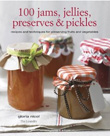STRAWBERRY & VANILLA JAM
Choose fruit that is as fresh as possible and just ripe or very slightly under ripe with no bad bits or discolouration. This jam is relatively low in sugar resulting in a soft set and strawberries also have a low pectin content, which is the ingredient needed for jam to set. Adding lemon juice, which is high in pectin, helps boost the pectin content. Make sure that jam jars and lids are clean and dry and sterilise by placing them in a warm oven for 20 minutes and always pour hot jam into hot jars, never cold. Those cellophane circles and elastic bands used as jam jar lids are all well and good and a lovely traditional touch, but screw-on lids are much more practical.
Makes 1.4kg
1 kg strawberries
1 vanilla pod
750g sugar
juice of 3 lemons
Don’t wash the fruit unless you really must and do so with the stalks in place taking care not to bruise the berries then dry the fruit thoroughly. Remove the stalks then cut large fruits in half and leave smaller fruits whole.
Place the fruit in a bowl, split the vanilla pod in half lengthways and scrape out the seeds from the middle then add the seeds and pod pieces to the strawberries, tucking the pod in amongst the fruit. Tip the sugar over the top to cover the strawberries and leave, covered with a plate or a tea towel, for approximately 12 hours by which time the juices from the fruit will have oozed out into the sugar.
Pour the contents of the bowl into a preserving pan and add the lemon juice. Heat slowly stirring gently now and again until you are sure that the sugar is completely dissolved and so that the fruit stays intact. Bring to a rolling boil and after 10 minutes test for setting point. Keep testing at 5 minute intervals as necessary till setting point is reached.
Take off the heat and remove the vanilla pod pieces. Leave the jam to cool for 10 minutes, stir to distribute the fruit then pour into hot jars, filling the jars right to the top. Place a greaseproof paper circle on the top, seal with a screw-top lid and leave till cold with the jars inverted.
THE BEST SCONES
The best scones come together really fast. Here sour cream is used to make them extra moist and rich but you can substitute buttermilk, mascarpone, yogurt or just milk mixed with the egg, really whatever you have handy at the time. Soured milk was traditionally used for scone making.
Makes about 10 scones
225g self-raising flour
pinch of salt
75g butter
30g caster sugar
1 egg
3 tbsp sour cream
Pre heat the oven to 220C (425F) Mk7
Sift the flour and salt into a bowl. Cut the butter into pieces and rub it into the flour until the mixture resembles breadcrumbs. Add the sugar. Beat the egg with the sour cream and add it to the mixture, keeping a tiny amount back for brushing on the scones and working quickly with a fork to form a dough which is soft but not sticky, also adding a splash of milk to the mixture if it feels too dry. Bring the mixture together with floured hands and press it onto a floured surface so it is about 2.5cm thick.
Cut out scones with a 5cm diameter cutter and place them onto a greased baking tray. Pull the dough offcuts together again and cut to make more scones. Brush the tops with the last of the egg mixture and bake for 10-15 minutes until they are risen and just starting to turn golden. Remove from the oven and cool on a wire rack.
When the scones are cold, split them and serve filled with clotted cream and strawberry and vanilla jam.






